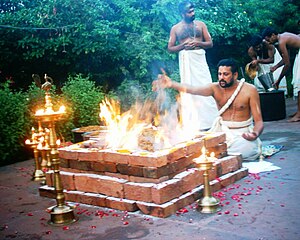হোম

ভাৰতীয় ধৰ্মত হোম হৈছে হিন্দু পুৰোহিতে বিশেষ অনুষ্ঠানত সাধাৰণতে গৃহস্বত্বাধিকাৰীৰ বাবে কৰা অগ্নিপূজন অনুষ্ঠান ("গৃহস্থ": ঘৰৰ অধিকাৰী)। গৃহস্থই বিভিন্ন ধৰণে জুইৰ ব্যৱহাৰ কৰে, য’ত খাদ্য ৰান্ধিবলৈ, ঘৰৰ উষ্ণতা বৃদ্ধি কৰিবলৈ, বা অন্যান্য ব্যৱহাৰৰ বাবে; সেয়েহে যজ্ঞবেলি পোনপটীয়াকৈ জুইত হোম দিয়া হয়।[1][2] হোমক কেতিয়াবা "বলিদানৰ অনুষ্ঠান" বুলিও কোৱা হয় কাৰণ জুইত দিয়া প্ৰসাদ জুইৰ উত্তাপে ধ্বংস কৰে, সেয়ে হোমক সঠিকভাৱে ক'বলৈ গ'লে "বলিদান অনুষ্ঠান" বুলিয়ে জনা যায়।[1] জুইয়েই কাৰক আৰু প্ৰসাদত বস্তুগত আৰু প্ৰতীকী যেনে শস্য, ঘিঁউ, গাখীৰ, ধূপ আৰু শস্য আদি অন্তৰ্ভুক্ত।[1][3]
ইয়াৰ উৎপত্তি হয় বৈদিক ধৰ্মত [4] আৰু প্ৰাচীন কালত বৌদ্ধ আৰু জৈন ধৰ্ময়ো ইয়াক গ্ৰহণ কৰিছিল।[1][3] ভাৰতৰ পৰা মধ্য এছিয়া, পূব এছিয়া আৰু দক্ষিণ-পূব এছিয়ালৈ এই প্ৰথা বিয়পি পৰে।[1] হোম অনুষ্ঠান বহু হিন্দু অনুষ্ঠানৰ এক গুৰুত্বপূৰ্ণ অংশ হৈয়েই আছে আৰু বৰ্তমানৰ বৌদ্ধ ধৰ্মত বিশেষকৈ তিব্বত আৰু জাপানৰ কিছু অংশত হোমৰ ভিন্নতা অব্যাহত আছে।[4][5] আধুনিক জৈন ধৰ্মতো ইয়াৰ প্ৰচলন দেখা যায়।[4][6]
হিন্দু ধৰ্মত হোমক যজ্ঞ বুলিও কোৱা হয়, কেতিয়াবা বৃহত্তৰ ৰাজহুৱা অগ্নিপূজন অনুষ্ঠানৰ বাবে বা বৌদ্ধ ধৰ্মত যজ্ঞবিধান বা গোম বুলিও কোৱা হয়।[3][7] আধুনিক যুগত হোমৰ ব্যৱহাৰ ব্যক্তিগত অনুষ্ঠান যেনে বিয়া আদিতো পোৰা দেখা যায়।[8]
ব্যুৎপত্তি
[সম্পাদনা কৰক]সংস্কৃত শব্দ হোম, হু মূলৰ পৰা আহিছে, যিয়ে "অগ্নিত ঢালি দিয়া, অৰ্পণ কৰা, বলিদান দিয়া"ক বুজায়।[9][10][11]
ইতিহাস
[সম্পাদনা কৰক]সমৰকন্দৰ পৰা জাপানলৈকে সমগ্ৰ এছিয়াতে ৩০০০ বছৰীয়া ইতিহাসত হোমৰ পৰম্পৰা পোৱা যায়।[4] হোম হৈছে সমগ্ৰ এচিয়াতে ভিন্ন পৰম্পৰাৰে জুইত খাদ্য উৎসৰ্গা কৰাৰ এক আনুষ্ঠানিক অনুষ্ঠান আৰু এয়া বৈদিক ধৰ্মত থকা পৰম্পৰাৰ সৈতে জড়িত।[4] এই পৰম্পৰাই এছিয়াত বিকশিত হোৱা জুই আৰু ৰন্ধা খাদ্য (পাকায়জ্ঞা)ৰ প্ৰতি থকা এক শ্ৰদ্ধা প্ৰতিফলিত কৰে আৰু বেদৰ ব্ৰাহ্মণ স্তৰসমূহেই এই আচাৰ-অনুষ্ঠানৰ শ্ৰদ্ধাৰ আদিম লিপি।[12]
যজ্ঞ বা যজ্ঞাহুতি আদিৰ শ্ৰুতি ৰীতি-নীতিৰ এক সুকীয়া বৈশিষ্ট্য হৈ পৰিছিল।[4] শ্ৰোত অনুষ্ঠান হৈছে কিবা পাবৰ বাবে কিবা এটা হেৰুৱাৰ এক পৰম্পৰা, য'ত অগ্নি আচাৰ-ব্যৱহাৰৰ জৰিয়তে এজন বলিদাতাই দেৱ-দেৱীক কিবা এটা আগবঢ়াইছিল আৰু বলিদানকাৰীয়ে বিনিময়ত কিবা এটা আশা কৰিছিল।[13][14] বৈদিক অনুষ্ঠানত খাব পৰা বা খোৱাব পৰা বস্তু[15] যেনে গাখীৰ, মাখন, দৈ, চাউল, যৱ, কোনো প্ৰাণী বা মূল্যৱান যিকোনো বস্তুৰ বলিদান দিয়া হৈছিল, যিবোৰ পুৰোহিতৰ সহায়ত দেৱতাসকললৈ আগবঢ়োৱা হৈছিল।[16][17] এই বৈদিক পৰম্পৰা শ্ৰোত (শ্ৰুতিভিত্তিক) আৰু স্মাৰ্ত (স্মৃতিভিত্তিক) বুলি বিভক্ত হৈছিল।[4]
ফিলিছ গ্ৰেনফৰ মতে হোম আচাৰ-ব্যৱহাৰ বিভিন্ন বৌদ্ধ আৰু জৈন পৰম্পৰাই পালন কৰিছিল আৰু তেওঁলোকৰ গ্ৰন্থসমূহে হিন্দু পৰম্পৰাৰ "আচাৰ-ব্যৱহাৰৰ বৰ্ণাঢ্যতা"ক মধ্যযুগীয় সময়ৰ মাজেৰে বিকশিত হোৱা তাৰতম্যৰ সৈতে নিজৰ কৰি লৈছিল।[4][6][18] মুছাছি তাচিকাৱাৰ মতে হোম শৈলীৰ বৈদিক বলিদানৰ অনুষ্ঠান মহাযান বৌদ্ধ ধৰ্মত নিমগ্ন হৈছিল আৰু তিব্বত, চীন আৰু জাপানৰ কিছুমান বৌদ্ধ পৰম্পৰাত হোম অনুষ্ঠান বৰ্তমানো চলি আছে।[5][19]
তথ্যসূত্ৰ
[সম্পাদনা কৰক]- ↑ 1.0 1.1 1.2 1.3 1.4 Richard Payne (2015). Michael Witzel. ed. Homa Variations: The Study of Ritual Change Across the Longue Durée. Oxford University Press. পৃষ্ঠা. 1–3. ISBN 978-0-19-935158-9. https://books.google.com/books?id=tIShCgAAQBAJ.
- ↑ Hillary Rodrigues (2003). Ritual Worship of the Great Goddess: The Liturgy of the Durga Puja with Interpretations. State University of New York Press. পৃষ্ঠা. 329 with note 25. ISBN 978-0-7914-8844-7. https://books.google.com/books?id=onyaEhwhJBUC.
- ↑ 3.0 3.1 3.2 Axel Michaels (2016). Homo Ritualis: Hindu Ritual and Its Significance for Ritual Theory. Oxford University Press. পৃষ্ঠা. 237–248. ISBN 978-0-19-026263-1. https://books.google.com/books?id=DSaxCgAAQBAJ.
- ↑ 4.0 4.1 4.2 4.3 4.4 4.5 4.6 4.7 Timothy Lubin (2015). Michael Witzel. ed. Homa Variations: The Study of Ritual Change Across the Longue Durée. Oxford University Press. পৃষ্ঠা. 143–166. ISBN 978-0-19-935158-9. https://books.google.com/books?id=tIShCgAAQBAJ.
- ↑ 5.0 5.1 Musashi Tachikawa (2015). Michael Witzel. ed. Homa Variations: The Study of Ritual Change Across the Longue Durée. Oxford University Press. পৃষ্ঠা. 126–141. ISBN 978-0-19-935158-9. https://books.google.com/books?id=tIShCgAAQBAJ.
- ↑ 6.0 6.1 Phyllis Granoff (2000), Other people's rituals: Ritual Eclecticism in early medieval Indian religious, Journal of Indian Philosophy, Volume 28, Issue 4, pages 399-424
- ↑ Richard Payne (2015). Michael Witzel. ed. Homa Variations: The Study of Ritual Change Across the Longue Durée. Oxford University Press. পৃষ্ঠা. 30, 51, 341–342. ISBN 978-0-19-935158-9. https://books.google.com/books?id=tIShCgAAQBAJ.
- ↑ Axel Michaels (2016). Homo Ritualis: Hindu Ritual and Its Significance for Ritual Theory. Oxford University Press. পৃষ্ঠা. 246. ISBN 978-0-19-026263-1. https://books.google.com/books?id=DSaxCgAAQBAJ.
- ↑ Wilhelm Geiger (1998). Culavamsa: Being the More Recent Part of Mahavamsa. Asian Educational Services. পৃষ্ঠা. 234 with footnotes. ISBN 978-81-206-0430-8. https://books.google.com/books?id=2KiFnbZzJkMC.
- ↑ উদ্ধৃতি ত্ৰুটি: অবৈধ
<ref>টেগ;axelmichaels231নামৰ refৰ বাবে কোনো পাঠ্য প্ৰদান কৰা হোৱা নাই - ↑ Hu, Sanskrit-English Dictionary, Koeln University, Germany
- ↑ Timothy Lubin (2015). Michael Witzel. ed. Homa Variations: The Study of Ritual Change Across the Longue Durée. Oxford University Press. পৃষ্ঠা. 143–145, 148. ISBN 978-0-19-935158-9. https://books.google.com/books?id=tIShCgAAQBAJ.
- ↑ Richard Payne (2015). Michael Witzel. ed. Homa Variations: The Study of Ritual Change Across the Longue Durée. Oxford University Press. পৃষ্ঠা. 2–3. ISBN 978-0-19-935158-9. https://books.google.com/books?id=tIShCgAAQBAJ.
- ↑ Michael Witzel (2008). Gavin Flood. ed. The Blackwell Companion to Hinduism. John Wiley & Sons. পৃষ্ঠা. 78. ISBN 978-0-470-99868-7. https://books.google.com/books?id=SKBxa-MNqA8C.
- ↑ Michael Witzel (2008). Gavin Flood. ed. The Blackwell Companion to Hinduism. John Wiley & Sons. পৃষ্ঠা. 79. ISBN 978-0-470-99868-7. https://books.google.com/books?id=SKBxa-MNqA8C.
- ↑ Sushil Mittal; Gene Thursby (2006). Religions of South Asia: An Introduction. Routledge. পৃষ্ঠা. 65–66. ISBN 978-1-134-59322-4. https://books.google.com/books?id=n7KCAgAAQBAJ.
- ↑ M. Dhavamony (1974). Hindu Worship: Sacrifices and Sacraments. Studia Missionalia. 23. Gregorian Press, Universita Gregoriana, Roma. পৃষ্ঠা. 107–108. https://books.google.com/books?id=kwLaO91rsu0C.
- ↑ Christian K. Wedemeyer (2014). Making Sense of Tantric Buddhism: History, Semiology, and Transgression in the Indian Traditions. Columbia University Press. পৃষ্ঠা. 163–164. ISBN 978-0-231-16241-8. https://books.google.com/books?id=GvUYBQAAQBAJ.
- ↑ Musashi Tachikawa; S. S. Bahulkar; Madhavi Bhaskar Kolhatkar (2001). Indian Fire Ritual. Motilal Banarsidass. পৃষ্ঠা. 2–3, 21–22. ISBN 978-81-208-1781-4. https://books.google.com/books?id=upXc2KdPlWkC&pg=PR12.
Text is available under the CC BY-SA 4.0 license; additional terms may apply.
Images, videos and audio are available under their respective licenses.
